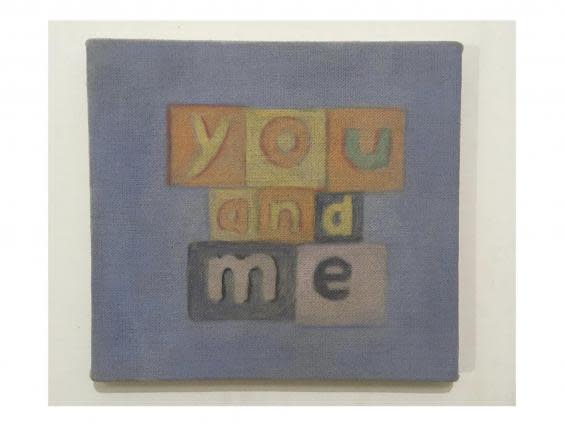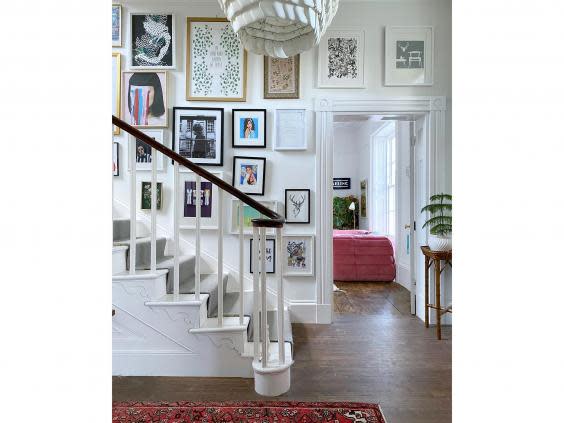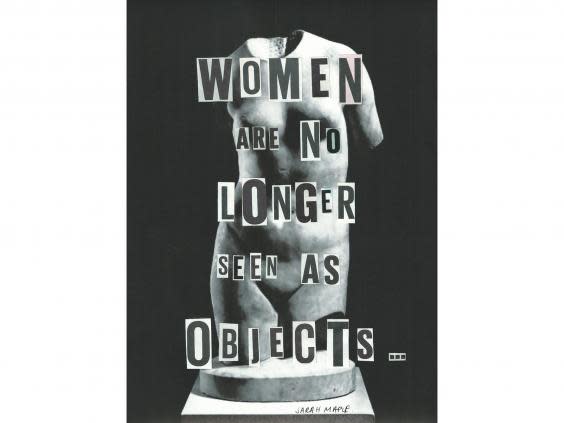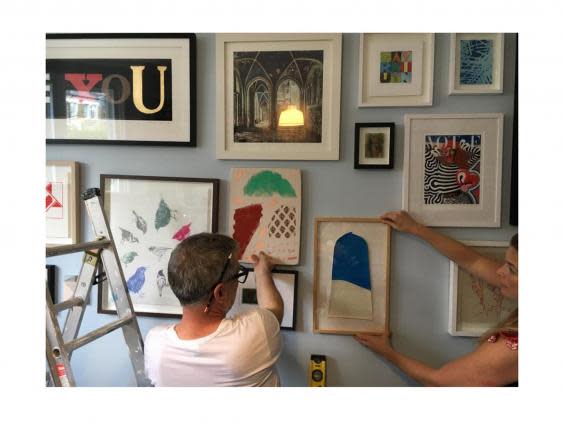How to create an Instagram-worthy gallery wall: Interiors experts on framing and displaying your art

Roughly defined as a curated display of photographs, paintings, prints, maps and even embroidery that are arranged on a wall – a gallery wall can be a great way to transform a space, add colour, personality and intention into your home.
You need just a hammer (or picture strips if you’re renting and not handy when it comes to filling holes), frame hooks and the items that you love.
“The trend for gallery walls continues through lockdown as people are spending more time updating their homes” says Katherine Lemin, partner and buyer at John Lewis & Partners.
The Affordable Art Fair has experienced record sales which are up 145 per cent from this time last year, as lockdown spurred the nation to become collectors, with Londoners accounting for 38 per cent of all spend across the UK.
Buying trends suggest art lovers are searching and buying pieces that offer a sense of calm – with birds, woodland and natural landscapes being the most popular. And Brits are seemingly attempting to create a “stay-cation” from their sofa with prints of coastal and countryside locations selling fast.
Deborah Allan, director of Wychwood Art, a gallery in Deddington affiliated with the Affordable Art Fair, and specialist in entry-level work said: “Art has the power to change much more than a room. The positive effect it can have on your mood, especially at a trying time, is immeasurable.”
While gallery walls exude effortless efficacy, the truth is, displaying your art collection takes a little bit of planning. But, read our guide and you’ll be well on your way to creating an Instagram-worthy wall in no time.
You can trust our independent round-ups. We may earn commission from some of the retailers, but we never allow this to influence selections, which are formed from real-world and expert advice. This revenue helps us to fund journalism across The Independent.
Tips and tricks of gallery walls
Creating the perfect gallery wall takes variety and confidence, but it can help make a space look wider, brighter, or taller says Kate Bryan, art historian, head of collections at Soho House and author of The Art of Love: The Romantic and Explosive Stories Behind Art Couples.
A captivating gallery wall should look and feel connected, so find a system that works for you. “Start from the middle and add things in organically over time by placing work slightly diagonally left or right. Be careful the edges don’t match – everything should occupy its own space and shouldn’t accidentally line up with something below or beneath or to the side.”
Alternatively, if you have your whole collection ready to display and want to go for a more formulaic approach you may want to mark out an imaginary perimeter using masking tape and fill the spaces.
Bryan suggests that if you opt for this, “to create a perfect rectangle use larger pieces in the corners to give the wall a good foundation visually and fit everything between these anchor points”.
Your space
You don’t need to have large amounts of space to display art. If you’re looking to fill a small wall, Bryan suggests being more experimental, opt for a “circular scaling hang of similar sized work as if radiating out from a sun.”
If it’s narrow areas you’re trying to fill, “emphasise the height, and if you’re placing above a sofa emphasise the width”.
In larger, open plan spaces, you have more freedom to be playful and creative with the arrangement and diversity of materials you are using.

If you’re looking to experiment with different media, Bryan has recently acquired a painting by Ben Walker (£200), take a look at Walker's work on his Instagram.

As for staircases, interiors writer Lisa Dawson, told The Independent that it’s important to “go with the flow, have confidence and trust your gut”. When curating hers, she started at the bottom left of the stairs, went upwards, across and then downwards, and mix and matched frames to create a cohesive focal point in her hallway.
Sourcing art
If you’re starting out, “take risks, enjoy the process and trust your gut. Don’t buy what you are “supposed” to buy, buy what you love. It will mean so much more” says Kate Bryan.
There are a number of websites to use to fill your home with art, affordably.
Prints provide a simple way of adding personality and make a great gallery wall in and of themselves.
They're particularly good if you're not able to buy originals, or if the pieces you are after are slightly more trend-led.
Desenio, a Scandinavian interior design company, sells posters that cover a huge range of tastes that are also available in lots of different sizes – from, block colour palm prints (Desenio, from £12.95) to abstract line drawings (Desenio, from £8.95).

Tap into the Matisse style trend with a minimalist print, with this abstract figures poster (Desino, from £9.95).
Alternatively, Lisa Dawson suggests looking on Print Club London, a company specialising in limited edition screen prints that have been carefully curated, so you know you will receive something that is high-quality.

We particular love Adam Brigland's You and I, Me and You (Print Club London, £70).
Similarly, Nine x Nine is a one-stop-shop that sells illustrated designs created by up and coming artists from around the world.
It has an impressive range of bold and colourful slogans, such as Fearless by Rachel E Miller (Nine x Nine, from £40) to more simple line drawings such as Sunday by Poppy Chancellor (Nine x Nine, from £40).

Friendship by Egle Plytnikaite (Nine x Nine, from £40) illustrates the beauty of long lasting friendship – a bold and bright piece that would work well in a gallery wall.
If you are after original works though, there are other ways to expand your collection beyond prints that still won't cost the earth.
Kate Bryan suggests looking at the #artistsupportpledge tag on Instagram – an initiative where artists upload the work that they are willing to sell for £200 or less and once they’ve made £1,000 in sales, they pledge to buy another artist’s work.
Editions start from less than £100 at the Jealous Gallery, and The Other Art Fair is “an amazing place to acquire work directly from artists” – Bryan recently discovered Gommine (@gommie_poem), a rising star there last year. While fairs are currently postponed, you can still buy work online.
In the current climate, Bryan noted that there are a range of charity editions being created by museums, for example the Hospital Rooms, which is a series by artists such as Anish Kapoor and Richard Wentworth, with each limited edition poster costing just £50.
If you’re looking to really get into the art world, try and build relationships with reputable young galleries – for example, Blue Shop Cottage, Bosse and Baum, Arcadia Missa, Sunday Painter, Sid Motion Gallery, and Soft Opening. You can also show your support to young artists and acquire art from graduate school shows, which are operating online this year because of coronavirus.

Worried about the art eco-system, Bryan has spent lockdown investing in key pieces – for example, Women Are No Longer Seen As Objects by Sarah Maple (Limited edition, £200).

While this is a limited edition piece, we love Maple's You Could Have Done This edition (Sarah Maple, £85) available on her website.
The most important thing though is to enjoy the process, if you're sourcing form local galleries of artists directly, “you are investing in people, in the creative community, in the future of art," said Bryan.

Deborah Allan, director of Wychwood Art, suggests adding illusive work into your home – for example, the likes of printmaker Kate Heiss. Of her collection, the Balearic Sunshine (Affordable Art Fair, £95) provides the perfect antidote for many.

This Birds of Paradise (Desenio, from:£8.95) print works to a similar affect – offering a way of adding vibrancy into your gallery wall.
“If you’re looking to put something on your wall, make sure you love it – from experience if you buy something because it is on trend or you’ve been influenced by social media, the chances are you might not love it in a few years to come” said Lisa Dawson. With this in mind, she suggested looking at King & McGaw, which sells a range of limited edition prints, as well as Homeplace for a mix of mid-century art.

Her favourite piece at the moment? Kate Boxer’s Come Here & I'll Show You Something limited edition drypoint and oil pastel painting (Affordable Art Fair, £1,320).
Mix it up
Gallery walls can be a fun way to create an uplifting statement in your home.
Kate Bryan advises using “as many different types of media as possible: small unframed canvases, framed mounted photographs, float mounted drawings or prints, embroidery, collages, painted wood or plates”, spreading them out so as to create a real mix.

Similarly, Lisa Dawson suggests juxtaposing art and textures so that the eye is drawn to lots of different things – from old family photos and limited edition prints to Chinese tapestries. When curating the pieces for her staircase, it took her six months to find the artwork that reflected her personality. From buying old frames and photos from charity shops to collating limited edition prints and old family photos blown up on canvas, she stressed that it needn't be expensive stuff, rather a collection of old and new.
While Joanna Thornhill, interiors stylist, writer and author of Office & Other Interior Design Dilemmas, suggests framing or hanging non-art pieces as a way decorate your walls. She suspends single drops of fabric and wallpaper on coat hangers around her home, and uses old newspaper cuttings flattened and framed, and even sections of vintage vinyl floor stuck onto canvas.
Gallery walls can be a mix of things you've acquired over the years and needn't be unaffordable – try hanging a large bold print, such as a this cyra poster (Desenio, from £12.95) next to a small family photo and even a line drawing, similar to Jessica Yolanda Kaye's designs, that you've drawn yourself.
To affordably acquire a real range of media – prints, wall hangings and embroidered pieces can all be sourced from the likes of Desino or Etsy, a maker-led site for up-and-coming creators.
To frame or not frame?
When visualising your gallery wall, it can be tempting to stick to a formula of the same frame for every piece.
But Bryan suggests that it’s nicer when not everything is framed – when she is creating a collection at Soho House, for example, she prefers it to look as though it has been put together organically over time.
When planning it in your head, it’s worth remembering Bryan's top tip: “Nothing too designed, the art must come first.”
Framing your prints, photos and artwork can be a nerve-wracking process, to elevate this, “find a good local framer (local always seems to be cheapest) and go in person to have a chat,” said Bryan.
“Take their advice on what is best for the particular work, whether something needs to be mounted or even spray mounted (not advisable for important work as it’s literally being fixed in place and then cannot be reframed).”
Museum level framing – a bespoke framing solution that is the highest level available – doesn’t cost that much more.
But, “if you have a key work, like a vintage photograph or original drawing by an established artist, you need to do this” said Bryan. “It means acid free backing board, UV resistant glass and of course don’t place in direct sunlight.”
She adds that: “Painted canvases on the other hand are going to be the hardiest things you can own and pass down.”
For inexpensive pieces, Bryan suggests buying readymade frames – she’s previously used a Poundshop number for a Jeremy Deller piece.
Another obvious for obtaining cheap frames is Ikea – the ribba frame (Ikea, £19) is a trusty favourite, along with the ramsborg (Ikea, £19). While Wilko hits the mark with its range of affordable frames, including A4 photo frames (Wilko, £2.50).
Proper preparation
Once you've assembled and framed your collection, you may want to seek inspiration from other people.
Blogger Megan Ellaby said she's "regularly saving inspiration from the likes of Instagram, Pinterest and blogs" and likes to save up pieces of art until a theme jumps out – often a colour palette.
"Things needn’t be perfectly aligned – indeed, a mix of sizes feels less formal and also makes it easier to add new pieces in the future without upsetting the balance" said Joanna Thurnhill.

She also suggests trying to bring an element of consistency, such as equal spacing between each frame, or ensuring the overall layout creates a rectangular shape.
Before you get hammer happy, measure the wall you plan to hang your art on and clean some space on your floor in front or nearby. Bryan suggests lying “all the work flat on the floor and move it around until you are happy with the plan. Stand on a chair, take an aerial photo and then hold your phone up to the wall to see an impression of what it might look like.”
Once you're happy with your masterpiece, do not forget to have a pencil on hand to mark your nail spots, a tape measure and a spirit level. If you’re currently in a rented property, thanks to Command picture strips (Amazon, £9.46) you can hang your pictures without the need of nails or screws – just make sure you determine the right ones for the size and weight of your frames.
Read more
How to bring the Matisse-inspired interiors trend into your home

 Yahoo News
Yahoo News 
